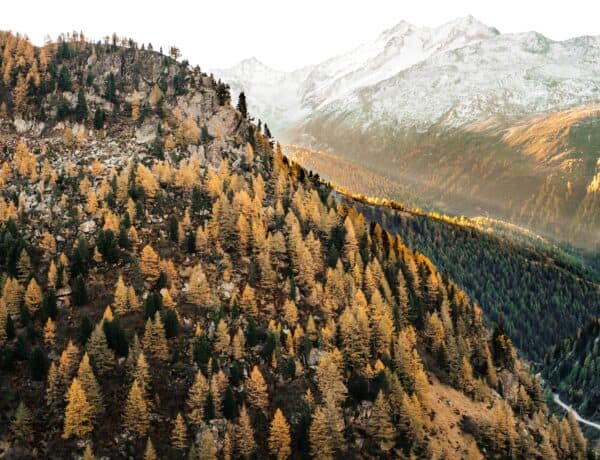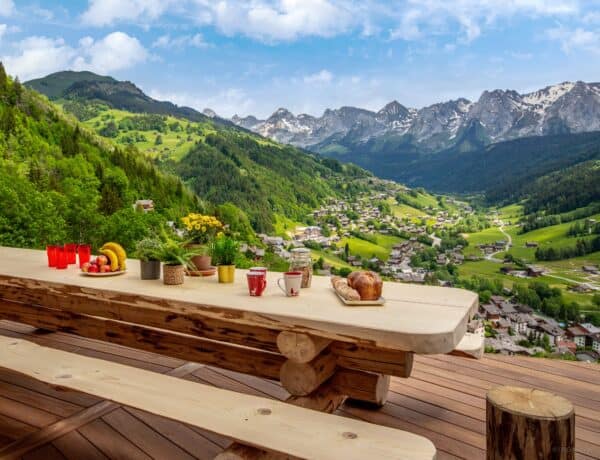The French Alps are rich in biodiversity and home to a wealth of wildlife – cattle, birds of prey, and insects… But they all have their own characteristics and their own way of life, from diet and habitat to mating and hibernation, they are all different.
If you are observant and discreet, you may be lucky enough to come across some of these animals when you are out hiking or cycling.
Summer is the perfect time to explore the mountains, breathe the fresh air and discover the many species of wildlife that live here.
Which animals will you come across on your mountain hike this summer? Here are some suggestions from the OVO Network team.
The ibex – strong and silent
⚖️ Weight: from 65-100kg for the male and 50km for the female
📏 Size: From 85-92cm for the male and 70-78cm for the female (to the withers)
🍏 Diet: Plants and grasses
⛰️ Where to see it? High up, on steep, stony slopes
The ibex is one of the easiest mountain animals to spot, as it’s not shy, and is fairly curious.
It’s not too difficult to get quite close to one, to take a closer look at its impressive ringed and arched horns, which can grow up to a metre long (for a male).
However, you will probably have to do a bit of climbing, as the ibex likes steep terrain and high grasslands, that animals or visitors haven’t trampled.
Beware: although it’s not shy, it’s still a wild animal so make sure you respect its space.

The chamois, a symbol of the Alps
⚖️ Weight: 35-50kg
📏 Size: about 80cm (to the withers)
🍏 Diet: vegetation and grasses
⛰️ Where to see it? In the middle mountains, on steep, stony slopes
Less easy to spot than the ibex, the chamois is still an iconic symbol of the Alps.
Lively and agile, this animal lives lower down the mountains, on the steepest, rocky outcrops. You’ll need a good pair of binoculars if you want to see one, or you’ll need to climb out to these inaccessible places.
The chamois is easy to recognise by its thin black horns, small tail and its brown coat in the summer.
The golden eagle – king of the skies
⚖️ Weight: from 2.9-6.6kg
📏 Size: a wingspan of about 2m
🍏 Diet: rodents and mammals
⛰️ Where to see it? In the sky around the summits
The golden eagle is undoubtedly one of the most well-known birds in the Alps.
If you want to see one, we suggest taking a trip to the mountains in the summer, when they are more visible. Life is pretty hard for this bird: it has to feed its young, which were born at the end of the spring, as they are not yet capable of hunting on their own.
This impressive raptor, with a wingspan of more than two metres, is known for its speed, which can reach up to 200km/h, its agility and its incredible eyesight- it can see a 10cm object at a height of one kilometre! It can be recognised by its yellow, hooked beak and its black plumage.
As for diet, it’s not too fussy, feeding on all kinds of small prey such as rabbits, marmots and squirrels. But it will also take larger animals such as foxes, young goats or wild cats.

The sheep, an emblem of the mountain landscape
⚖️ Weight: 55-65kg
📏 Size: 65cm to the withers
🍏 Diet: fresh grass and pasture
⛰️ Where to see it? In the Alpine meadows
Alpine sheep are an important part of the summer mountain landscape, so you’re sure to come across them.
After spending winter in the barn, the animals are taken to the mountains, where they will spend the summer. The herds will spend three to four months enjoying the fresh grass before it is covered in snow again.
In Savoie and Haute Savoie, the most popular breed is the Thônes and Martod sheep. You can tell it by its twisted horns, thick fleece and distinctive colours – white with black muzzle, eyes and ears.
Beware: Some mountain pastures are not fenced and are often guarded by dogs trained to protect the sheep from aggression. If you come across a sheepdog, there are certain guidelines you should follow to stay safe, make sure to read them before you set off on your walk.
The marmot – the mountain mascot
⚖️Weight: 4-8kg
📏 Size: 50-70cm
🍏 Diet: clover, flowers, buds, roots, bulbs, seeds, fruit, bark and some insects
⛰️ Where to see it? On sunny slopes
After hibernating all winter to avoid the freezing temperatures and lack of food, the marmot returns to the mountainsides at the first sign of sunshine.
You’ll hear their whistles echoing around the mountains when the sun comes out. These piercing whistles are used to warn their companions of possible danger around the burrow – click here to hear the cry.
And if you have a keen eye, you may be lucky enough to spot them. But you’ll have to be patient, as these little creatures are experts at hiding!
For the best chance of spotting one, go for a walk around the entrance to a wildlife park. The animals here will be used to humans and will be much less shy.

The bearded vulture, guardian of the summits
⚖️ Weight: 5-7kg
📏 Size: A wingspan of about 2m 80cm
🍏 Diet: carcasses (bones, tendons, ligaments…)
⛰️ Where to see it? In the sky, at a high altitude
For many years, the bearded vulture was exterminated and threatened with extinction because of its size and its way of life. It was seen as an evil bird that attacked herds and killed its prey.
It’s only recently that people have realised that this wild bird is not as terrifying as it was believed to be.
Rather than killing its prey, the vulture feeds solely on the carcasses of dead animals, and the red stains often seen on its belly are not blood, but the soil it uses to clean itself!
It was also discovered that the vulture is of great ecological value. By feeding on rotting flesh, the vulture prevents infection and protects waterways from pollution caused by decomposition. It’s not called “nature’s garbage collector” for nothing.
The bearded vulture was re-introduced to the Alps in the 1980s, and you’re more likely to see one now than a few years ago. But this wild bird is still fairly rare. Although pairs have now bred and their numbers are gradually increasing, there are only 250 in the whole of the Alps.
The cow, star of the mountains
⚖️ Weight: 550-650kg
📏 Size: About 1m 35cm
🍏 Diet: Fresh grass and pasture
⛰️ Where to see it? In the Alpine meadows
A herd of cows grazing peacefully in the lush mountain pastures – it’s not just a postcard, but a typical Alpine scene!
If you are out in the mountains in the summer, it’s not unusual to come face-to-face with a herd of cows – in particular, Abondance or Tarentaise cows, which are two typical breeds in Savoie.
When the warm weather comes, the herds leave the valleys to spend their days happily in the pastures – a journey called the “transhumance”. This event takes place every year, on about May 25th.
Beware! Although these animals have become domesticated by humans, please don’t approach them. Their behaviour can be unpredictable and they won’t hesitate to charge if they feel threatened. Here are some tips on what to do if you come across a herd of cows in the mountains.
- Don’t try to approach them and stroke them
- Walk around the herd, even if it is in the middle of the path
- Avoid sudden movements and keep calm
- If you have a dog, keep it on a lead

So now you know all about the most common animals that live in our beautiful mountains. There are lots of activities that might introduce you to these animals, whatever your destination – the Portes du Soleil, the Aravis or La Plagne…
With a good pair of binoculars and a lot of patience, you should be able to spot them. And everything comes to those who wait, or so they say…
If you do happen to turn a corner and come across one, don’t hesitate to share your photographs with us on our social networks!



